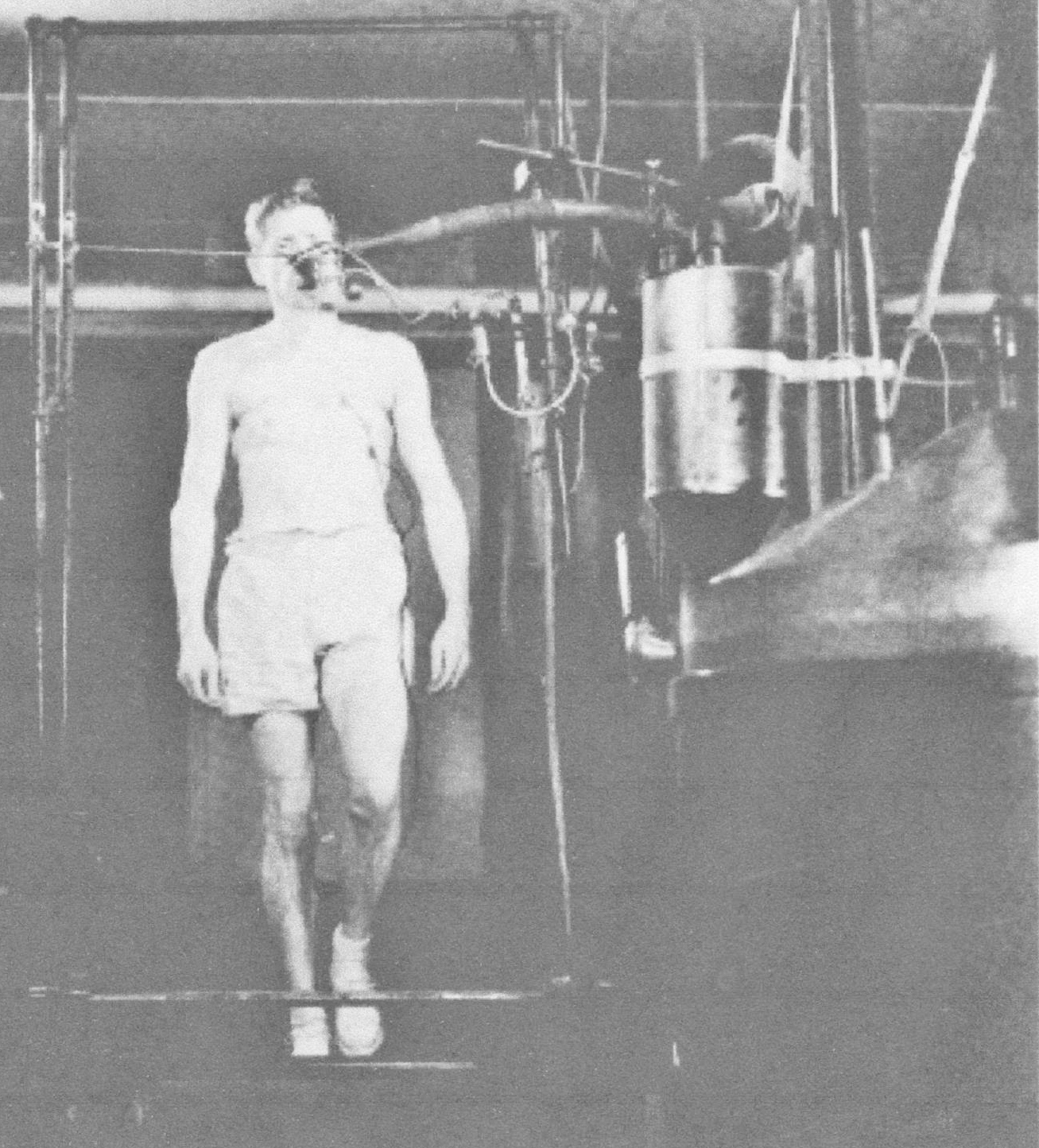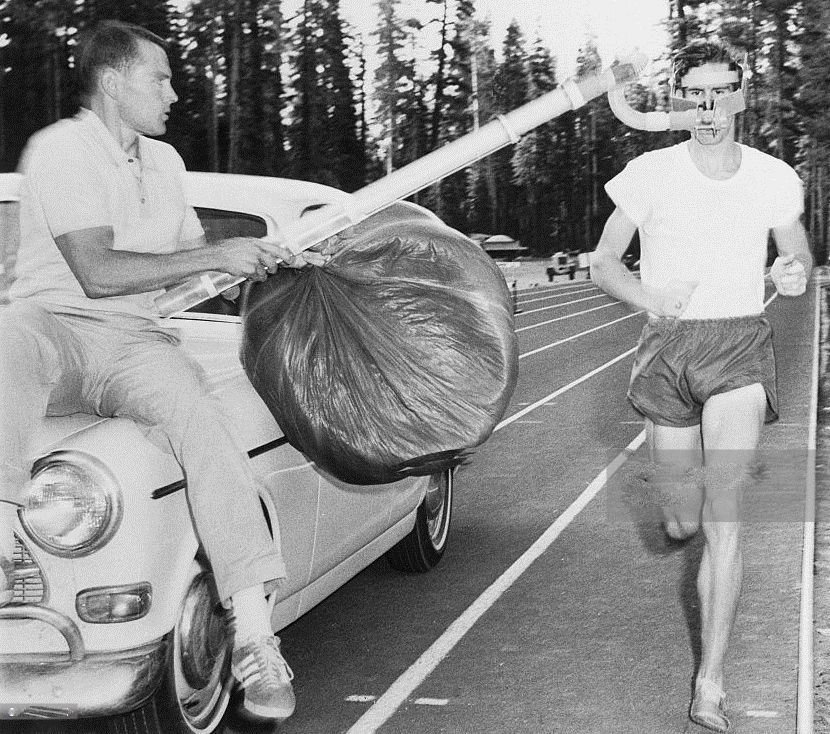By Phillip B. Sparling
Many scientists worldwide have made lasting contributions to today’s scientific understanding of distance running. During the first half of the 20th century, a number of notable Americans paved the way. With insatiable curiosity and drive, early researchers used the best scientific tools available to unravel the physiology of endurance performance. They were scientific explorers of physical performance. Here are a few.
D.B. Dill & S. Robinson: From 1927-1947, acclaimed scientist David Bruce Dill (1891-1986) and colleagues at the Harvard Fatigue Lab studied champion runners as one of many approaches to investigate the physiology of performance and fatigue. Arguably their most famous subject was Clarence DeMar, 7-time winner of the Boston Marathon (1911, 1922-24, 1927-28, 1930). His participation in the lab’s experimental studies on exercise was instrumental in showing the enlarged heart of distance runners was the consequence of conditioning, not pathology (1, 2). In 1936 Dill and doctoral student Sid Robinson (1902-1982) assessed the work capacities of Glenn Cunningham and Don Lash, world record holders at 1-mile and 2-mile, respectively (3). Before joining Dill at Harvard, Robinson had competed in the 1500 meters in the 1928 Olympics and coached the Indiana University cross-country team to five straight Big Ten championships and three national championships. In 1939, he returned to Indiana University with an appointment in the department of physiology, where he created a nationally prominent research program in exercise and environmental physiology. Dill and Robinson posed basic and applied questions. What are the underlying biochemical changes and physiological mechanisms associated with distance running? And more broadly, how does physical training influence performance under different environmental conditions (in the heat or cold, at altitude)?

T.K. Cureton, B. Balke & K.H. Cooper: From the 1940s through the 1950s, T.K. Cureton (1901-1992), who established the Physical Fitness Research Lab at the University of Illinois, profiled Olympians and world record holders including Roger Bannister (4). An excellent runner and swimmer himself, Cureton was one of the first to promote vigorous exercise to improve the health of ordinary Americans. At the time, only athletes and soldiers engaged in serious physical training. In the 1950s and early 1960s, Bruno Balke (1907-1999) conducted fitness research for the Air Force and developed the 15-min test (5). Kenneth H. Cooper, a former flight surgeon in-training under Balke, proposed the 12-minute run a few years later (6). These field studies were the first to correlate maximal oxygen uptake to distance run performance in samples with large variations in fitness. In 1964 Balke accepted a position as professor of physical education and physiology at the University of Wisconsin. Cooper published his book Aerobics in 1968 and established the Aerobics Center in Dallas in 1970. Most investigations from the 1930s through the 1960s focused on cardiac, respiratory, blood lactate, and oxygen uptake measurements.
J. Daniels. Jack Daniels’ background is akin to that of Sid Robinson from a generation before. A medalist in the modern pentathlon in both the 1956 and 1960 Olympics, he studied exercise physiology with two eminent researchers: Per-Olof Astrand (Sweden) and Bruno Balke (University of Wisconsin) who was his doctoral advisor. As his dissertation dealt with human performance at altitude, he became a key advisor to American distance runners preparing for the 1968 Olympics in Mexico City (7,350 feet above sea level) (7, 8). An accomplished scientist, he chose coaching over research as his main career path. His coaching is uniquely infused with science. He advised many of the world’s finest runners from Jim Ryun to Joan Benoit (Samuelson), along with coaching hundreds of modestly-talented runners. He was a highly successful coach of women and men at SUNY-Cortland. He also directed Nike’s exercise science lab in Eugene, Oregon (associated with Athletics West, an elite runners club) and the Center for High Altitude Training in Flagstaff, Arizona. Editor Amby Burfoot at Runner’s World described Daniels as the world’s best coach.

D.L. Costill: In 1966, David Costill was hired to direct the Human Performance Lab at Ball State University (Muncie, Indiana). Over his 40 years there, he would conduct seminal physiological research on nearly every facet of distance running, test the world’s best runners – Derek Clayton (Australia), Alberto Salazar (USA), and Grete Waitz (Norway), to name a few – and become the pied piper for those fascinated with distance running (9). From across the USA and abroad, hundreds of runners, students, and scientists visited and studied with Costill. The overarching aim was to decipher what factors determine success in distance running, and how different types of training influence these variables. His initial papers identified lactate accumulation, glycogen depletion, fractional utilization of aerobic capacity, and temperature regulation as important variables (10-13). These findings had direct, practical impact on training and diet (e.g., threshold training, carbohydrate loading, fluid replacement). He was also among the first to perform muscle biopsies and fiber typing on distance runners (14), learning the techniques from Swedish scientist Bengt Saltin (1935-2014) and American physiologist Philip Gollnick (1935-1991) (15). Costill translated the concept of fast-twitch vs. slow-twitch muscle fibers to coaches and runners, helping them understand a genetic determinant of performance.
All devoted exercisers, these pioneering scientists were driven to learn more about the capacity of the human body. They conducted hands-on research in small labs with eager co-workers and students, often using themselves as test subjects. They laid the foundation. By 1970s, a new era in research on distance running began as new technologies and specializations within exercise science emerged. Part II of this retrospective will highlight two landmark multi-disciplinary projects.
Read part two here: Distance Running Part II: Landmark Research Projects and Science-Based Books
***************
Phil Sparling is a professor emeritus of applied physiology at the Georgia Institute of Technology (Georgia Tech) in Atlanta, Georgia, USA. Decades ago he was a competitive distance runner and marathoner. He still runs several days a week. phil.sparling@gatech.edu
References
(1) Dill DB, Talbott JH, Edwards HT. Studies in muscular activity. J Physiol 69: 267-305, 1930
(2) Dill DB. Marathoner DeMar: physiological studies. J Natl Cancer Inst 35: 185-191, 1965
(3) Robinson S, Edwards HT, Dill, DB. New records in human power. Sci 85: 409-410, 1937
(4) Cureton TK. Relationship of physical fitness to athletic performance and sports. JAMA 162: 1139-1149, 1956
(5) Balke B. A simple field test for the assessments of physical fitness. Report 63-6 of Civil Aeromedical Research Institute (pp 1-8), Federal Aviation Agency 1963
(6) Cooper KH. A means of assessing maximal oxygen intake: Correlation between field and treadmill testing. JAMA 203: 201-204, 1968
(7) Balke B, Nagle FJ, Daniels J. Altitude and maximum performance in work and sports activity. JAMA 194: 646-649, 1965
(8) Daniels J & Oldridge N. The effects of alternate exposure to altitude and sea level on world-class middle-distance runners. Med Sci Sports 2: 107-112, 1970
(9) Kolata G. David Costill: A Career Spent in Study of Training and Exercise, Lap by Grueling Lap. The New York Times. October 30, 2001 www.nytimes.com/2001/10/30/health/scientist-work-david-costill-career-spent-study-training-exercise-lap-grueling.html?pagewanted=all
(10) Costill DL. Metabolic responses during distance running. J Appl Physiol 28: 251-255, 1970
(11) Costill DL, Bowers R, Branam G et al. Muscle glycogen utilization during prolonged exercise on successive days. J Appl Physiol 31: 834-838, 1971
(12) Costill DL, Thomason H, Roberts E. Fractional utilization of the aerobic capacity during distance running. Med Sci Sports 5: 248-252, 1973
(13) Costill DL & Sparks KE. Rapid fluid replacement following thermal dehydration. J Appl Physiol 34: 299-303, 1973
(14) Costill DL, Daniels J, Evans W et al. Skeletal muscle enzymes and fiber composition in male and female track athletes. J Appl Physiol 40: 149-154, 1976
(15) Gollnick PD, Armstrong RB, Saubert CW et al. Enzyme activity and fiber composition in skeletal muscle of untrained and trained men. J Appl Physiol 33: 312-319, 1972